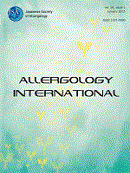58 巻, 4 号
選択された号の論文の19件中1~19を表示しています
- |<
- <
- 1
- >
- >|
REVIEW ARTICLE
-
2009 年 58 巻 4 号 p. 457-466
発行日: 2009年
公開日: 2009/12/15
PDF形式でダウンロード (248K) -
2009 年 58 巻 4 号 p. 467-474
発行日: 2009年
公開日: 2009/12/15
PDF形式でダウンロード (271K) -
2009 年 58 巻 4 号 p. 475-483
発行日: 2009年
公開日: 2009/12/15
PDF形式でダウンロード (400K) -
2009 年 58 巻 4 号 p. 485-491
発行日: 2009年
公開日: 2009/12/15
PDF形式でダウンロード (132K) -
2009 年 58 巻 4 号 p. 493-498
発行日: 2009年
公開日: 2009/12/15
PDF形式でダウンロード (267K)
ORIGINAL ARTICLE
-
2009 年 58 巻 4 号 p. 499-508
発行日: 2009年
公開日: 2009/12/15
PDF形式でダウンロード (485K) -
2009 年 58 巻 4 号 p. 509-518
発行日: 2009年
公開日: 2009/12/15
PDF形式でダウンロード (350K) -
2009 年 58 巻 4 号 p. 519-527
発行日: 2009年
公開日: 2009/12/15
PDF形式でダウンロード (257K) -
2009 年 58 巻 4 号 p. 529-535
発行日: 2009年
公開日: 2009/12/15
PDF形式でダウンロード (351K) -
2009 年 58 巻 4 号 p. 537-542
発行日: 2009年
公開日: 2009/12/15
PDF形式でダウンロード (245K) -
2009 年 58 巻 4 号 p. 543-548
発行日: 2009年
公開日: 2009/12/15
PDF形式でダウンロード (120K) -
2009 年 58 巻 4 号 p. 549-555
発行日: 2009年
公開日: 2009/12/15
PDF形式でダウンロード (153K) -
2009 年 58 巻 4 号 p. 557-564
発行日: 2009年
公開日: 2009/12/15
PDF形式でダウンロード (435K) -
2009 年 58 巻 4 号 p. 565-572
発行日: 2009年
公開日: 2009/12/15
PDF形式でダウンロード (619K) -
2009 年 58 巻 4 号 p. 573-583
発行日: 2009年
公開日: 2009/12/15
PDF形式でダウンロード (735K) -
2009 年 58 巻 4 号 p. 585-589
発行日: 2009年
公開日: 2009/12/15
PDF形式でダウンロード (317K) -
2009 年 58 巻 4 号 p. 591-597
発行日: 2009年
公開日: 2009/12/15
PDF形式でダウンロード (1185K) -
2009 年 58 巻 4 号 p. 599-603
発行日: 2009年
公開日: 2009/12/15
PDF形式でダウンロード (154K)
CORRIGENDA
-
2009 年 58 巻 4 号 p. 605
発行日: 2009年
公開日: 2009/12/15
PDF形式でダウンロード (348K)
- |<
- <
- 1
- >
- >|
